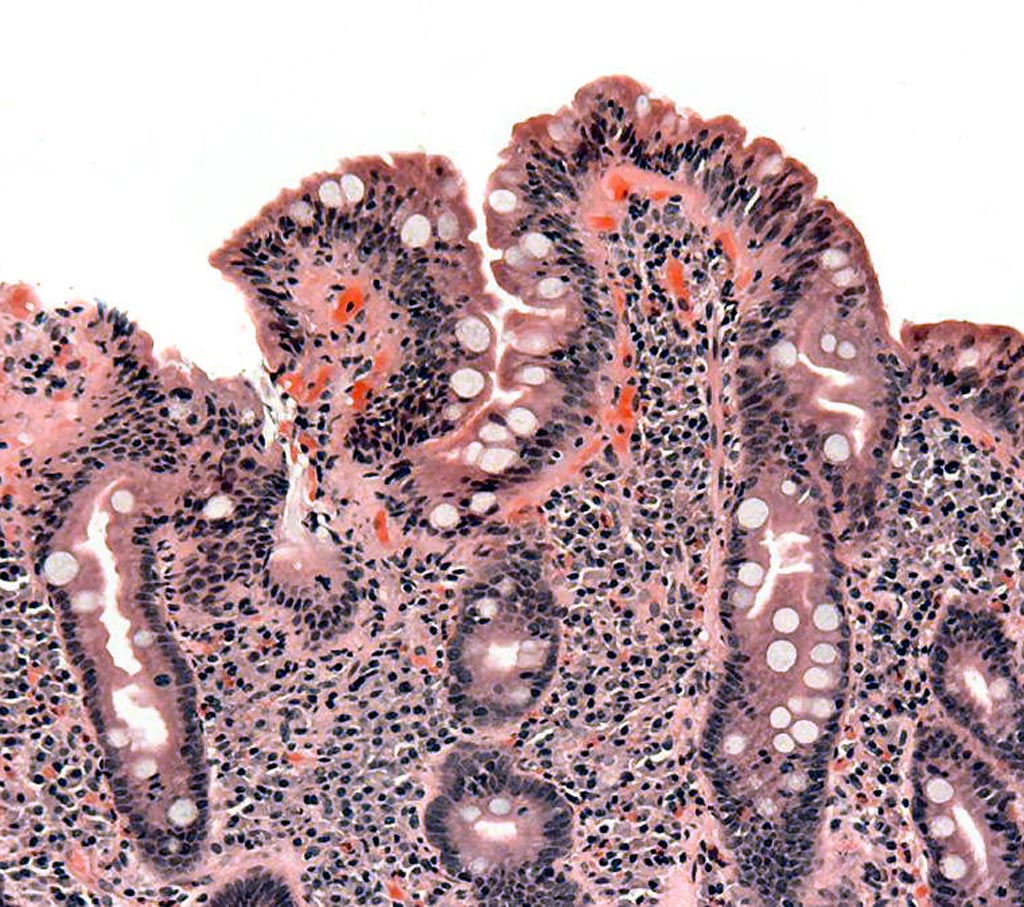A One-step Rapid Point-of-Care Assay for Diagnosis of Celiac Disease
By LabMedica International staff writers
Posted on 12 Dec 2019
A spectrophotometric assay has been developed that shows strong potential for use as a point-of-care (POC) assay for the rapid detection of celiac disease antibodies.Posted on 12 Dec 2019
Celiac disease (CD) is an autoimmune disorder usually presenting with non-specific gastrointestinal symptoms. It affects approximately 1% of world population, with more than 90% of cases being undiagnosed or misdiagnosed. The diagnosis of CD is currently based on serology and intestinal biopsy, with detection of anti-tissue transglutaminase (tTG) IgA antibodies recommended as the first-line test. Enzyme immunoassays (EIAs) are the established approach for anti-tTG antibody detection, while the existing point-of-care (POC) tests lack sensitivity and/or specificity. Improved POC methods could help reduce the under diagnosis and diagnostic delay of CD.

Image: Biopsy of small bowel showing celiac disease manifested by blunting of villi, crypt hypertrophy, and lymphocyte infiltration of crypts (Photo courtesy of Wikimedia Commons)
In this regard, investigators at the University of Helsinki (Finland) formulated an assay for the detection of anti-tTG antibodies by modifying a rapid homogeneous immunoassay based on time-resolved Förster resonance energy transfer (TR-FRET) that they had developed for serodiagnostics of hanta- and Zika virus infections.
TR-FRET is a phenomenon occurring when two fluorophores, donor and acceptor, are in close proximity. Excitation of the donor leads to energy transfer to the acceptor, which then emits the energy at a characteristic wavelength. The TR-FRET efficiency depends inversely on the distance between the two fluorophores. Background autofluorescence is minimized by time-resolved measurement, enabled by chelated lanthanide fluorophores with a long fluorescence half-life. TR-FRET has been employed widely in research and diagnosis to investigate protein-protein interactions and disease markers.
The investigators modified a rapid wash-free TR-FRET-based method for antibody detection by coupling it to the antibody-binding protein “protein L” (LFRET). LFRET employs a donor-labeled antigen, and an acceptor-labeled protein L, which binds the kappa light chains of all immunoglobulin classes. If the clinical sample contains antibodies against the antigen, they will bring the fluorophores to close proximity. Thus, the TR-FRET signal shows that the sample contains the antibodies of interest. The LFRET signal can be measured without additional steps shortly after combining the sample with the reagent mix, allowing for rapid point-of-care diagnosis.
For the anti-tTG antibodies study, the investigators evaluated 74 patients with biopsy-confirmed CD and 70 healthy controls, with 1) the new tTG-LFRET assay, and for reference 2) a well-established EIA, and 3) an existing commercial POC test. IgG depletion was employed to differentiate between anti-tTG IgA and IgG positivity.
Results revealed that the sensitivity and specificity of the first-generation tTG-LFRET POC assay in detection of CD were 87.8% and 94.3%, respectively, in line with those of the reference POC test. For comparison, the sensitivity and specificity of EIA were 95.9% and 91.9%, respectively.
"The performance of the test was comparable to that of current methods. The prevailing method involves transporting the sample to a central laboratory and a multi-step procedure taking hours. With the new method, results can be achieved in less than half an hour by simply combining the sample and a reagent mix, waiting for a while and reading the result," said first author Dr. Juuso Rusanen, a researcher at the University of Helsinki. "We hope our rapid method could lower the threshold for screening of celiac disease and thus help overcome the vast under diagnosis of this relatively common condition. Additionally, this is the first time the new method has been used for diagnostics of autoimmune disease. This is a promising result, and prompts the development of similar tests for diagnostics of other autoimmune disorders."
The study was published in the November 26, 2019, online edition of the journal PLOS One.
Related Links:
University of Helsinki













